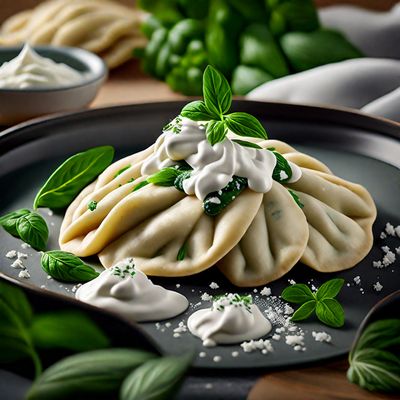
Ingredient
Yoghurt
The Creamy Delight: Unveiling the Secrets of Yoghurt
Yoghurt is a cultured dairy product made by fermenting milk with live bacteria cultures. It has a smooth and creamy texture, often described as velvety, and a slightly tangy taste. The appearance of yoghurt can vary from a thick and dense consistency to a more liquid form, depending on the processing method. It is commonly available in plain or flavored varieties, with options like Greek yoghurt, which is strained to remove excess whey, resulting in a thicker and creamier product. Yoghurt is known for its versatility, as it can be enjoyed on its own, used as a base for smoothies, dressings, or marinades, or incorporated into both sweet and savory dishes.
Origins and history
Yoghurt has a rich history that dates back thousands of years. Its origins can be traced to Central Asia, particularly in regions such as Turkey, Iran, and India. Nomadic tribes in these areas discovered that milk carried in animal skins would ferment due to the naturally occurring bacteria present. This accidental fermentation process led to the creation of yoghurt. Over time, yoghurt became an integral part of various cuisines and cultures, with its popularity spreading across the globe.
Nutritional information
Yoghurt is a nutrient-dense food, providing essential nutrients such as protein, calcium, vitamin B12, and probiotics. It is also relatively low in calories, making it a healthy choice for individuals seeking a balanced diet.
Allergens
Yoghurt is derived from milk and may contain lactose, making it unsuitable for individuals with lactose intolerance or milk allergies.
How to select
When selecting yoghurt, opt for varieties that are free from artificial additives, preservatives, and excessive sugar. Look for yoghurt with a smooth and creamy consistency, without any signs of separation or curdling. Additionally, check the expiration date to ensure freshness.
Storage recommendations
Yoghurt should be stored in the refrigerator at temperatures below 40°F (4°C) to maintain its freshness and quality. It is best consumed within the designated expiration date to ensure optimal taste and texture.
How to produce
Yoghurt can be produced at home by heating milk to a specific temperature, adding a small amount of yoghurt with live cultures as a starter, and allowing it to ferment at a controlled temperature for several hours. Detailed instructions and recipes are widely available for amateur yoghurt production.
Preparation tips
Yoghurt can be enjoyed as a standalone snack, used as a topping for granola or fruit, or incorporated into various recipes. It can be used as a marinade for meats, a base for creamy dressings or dips, or even as a substitute for sour cream in recipes. When using yoghurt in cooking, it is important to avoid high heat, as excessive heat can cause curdling. Instead, add yoghurt towards the end of the cooking process or use it as a finishing touch to retain its creamy texture.
Substitutions
Sour cream or buttermilk can be used as suitable substitutes for yoghurt in recipes that require a creamy and tangy element.
Culinary uses
Yoghurt is widely used in both sweet and savory dishes. It is commonly enjoyed as a breakfast staple with granola, honey, or fresh fruit. Yoghurt is also used in smoothies, parfaits, and frozen desserts. In savory dishes, it is used as a marinade for meats, a base for creamy sauces or dressings, and as an ingredient in dips and spreads.
Availability
Yoghurt is commonly available in grocery stores and supermarkets worldwide. It is also produced locally in many regions, particularly in areas with a strong dairy industry.
More ingredients from this category
Recipes using Yoghurt » Browse all

Kazakh-style Dry Pizza
Savory Delight: Kazakh-inspired Dry Pizza

Homemade Greek Tzatziki
Refreshing Yogurt Cucumber Dip: Homemade Greek Tzatziki Recipe

Bulgarian-style Riesling Chicken Stew
Riesling-infused Chicken Delight: A Bulgarian Twist on a French Classic

Jharkhandi-style Spiced Beef Curry
Flavors of Jharkhand: A Spicy Beef Curry Delight

Litti Chokha with a Twist
Smoky Baked Litti with Spicy Roasted Chokha

Afghan Khameerbob with Spiced Lamb
Saffron-infused Afghan Delight: Khameerbob with Fragrant Spiced Lamb

Greek Yogurt with Honey
Honey-Kissed Greek Yogurt Delight

Greek-style Spinach and Feta Pierogi
Mediterranean Delight: Spinach and Feta Stuffed Greek Pierogi

South Asian Spiced Club Sandwich
Savory Fusion: South Asian Spiced Club Sandwich

Jalamah with Spiced Lamb and Yogurt Sauce
Savory Delight: Spiced Lamb Jalamah with Creamy Yogurt Sauce

Mitho Lolo - Sweet Nepalese Pancake
Nepalese Delight: Sweet and Fluffy Mitho Lolo Pancakes

Albanian Tripe Soup
Hearty Delight: Albanian Tripe Soup


